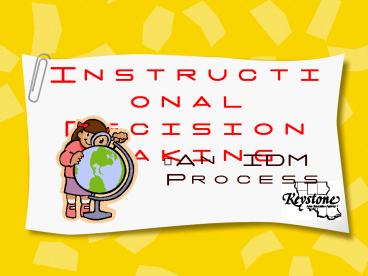Instructional Decision Making PowerPoint PPT Presentation
1 / 29
Title: Instructional Decision Making
1
Instructional Decision Making
An IDM Process
2
Instructional Decision Making Process
- Focused on improving students success through
solutions within the general education
environment. - Is an interactive, ongoing process that includes
students, parents, educators, caregivers,
administration, and AEA support staff.
3
IDM
- Uses data regarding students response to
instruction to determine future educational needs
and what educational services are required to
meet those needs. - This process is used for academic and behavioral
needs.
4
When implemented fully.
IDM IS DESIGNED TO ENABLE ALL STUDENTS TO BE
SUCCESSFUL!
5
Putting the Pieces Together
6
COMPREHENSIVE SCHOOL IMPROVEMENT
7
CSIP Comprehensive School Improvement Planning
Constant Conversation Questions
What do data tell us?
How will we evaluate?
What will we do?
How will we know there is change?
8
Instructional Decision Making
Core
S
I
9
(No Transcript)
10
Alignment of the Various Models Currently
Emphasized in Iowa Education
From the SINA Team at AEA 10, November 03
11
THE IDM PROCESS
12
IDM is a process that provides a common framework
and a standardized communication mechanism for
instructional decision-making. It aligns with
and supports all services and programs within a
school.
- The IDM process is
- Student focused
- Focused on appropriate instruction for ALL
students - Data driven
- A collaborative effort
- Proactive
- A seamless continuum of instructional delivery
- For all students
- Fluid, interactive, and responsive
13
IDM pulls it all together
- Curriculum Analysis
- Iowa Technical Adequacy Project (ITAP)
- Surveys of Enacted Curriculum
- Student Issues
- Talented and Gifted (NOW Gifted and Talented )
- English Language Learners
- At-Risk
- Migrant
- MCGF
- Neglected and Delinquent
- Special Education
- Title I
14
IDM pulls it all together
- Federal Mandates
- No Child Left Behind
- Schools in Need of Assistance (SINA)
- Individuals with Disabilities (IDEA)
- State Initiatives
- Comprehensive School Improvement Plan (CSIP)
- Iowa Professional Development Model (IPDM)
- Individual Career Development Plan (ICDP)
- District Career Development Plan (DCDP)
- Every Student Counts, Every Student Reads, Every
Learner Inquires
15
Bottom Line.
- IDM represents educational best practice and
helps schools evaluate their current available
resources to meet the instructional and
behavioral abilities of ALL students.
16
Core Instruction
- The district adopted comprehensive curriculum
- Provided for all students
- Screening and formative evaluations occur
Core Instruction
17
Components of Core Cycle
May be presented to the whole class. May be
delivered through flexible grouping. May be
presented differently to groups according to
needs.
18
Core CycleInstructional Program
- Core instruction is guaranteed. This means that
the intended curriculum (standards and
Benchmarks) is also the implemented curriculum
(delivered by the teacher). - Core instruction is viable. This means that the
curriculum content for each grade and/or course
can be adequately addressed in the time
available. - Content considered essential for all students is
identified and communicated for every grade level
and course. - Essential content is sequenced and organized in
such a way that students have ample opportunity
to learn it.
19
Supplemental Cycle
- Instruction that is available for students
identified as exceeding or not meeting core-
learning expectations - Provided to smaller groups of students with
similar needs - Research based/evidence based strategies selected
- Targeted instruction in identified area
- IN ADDITION TO CORE
Supplemental Instruction
Supplemental Instruction
20
Components of the Supplemental Cycle
- Focus on the identified student learning needs
- May involve the use of additional resources
within the classroom - May be changes in, intensity, consistency, and
immediacy of feedback - May include a change in instructional strategy
21
Intensive Cycle
- Instruction that is available for students
identified as significantly exceeding or not
meeting core and/or supplemental learning
expectations - Provided to individuals or small groups of
students with similar needs - Research based/evidence based strategies selected
- IN ADDITION TO CORE
Supplemental Instruction
Intensive Instruction
Intensive Instruction
22
Components of theIntensive Cycle
Often includes different instructional
strategies Lesson plan prescribed for the
individual Provided to individuals or small
groups of students Often includes other support
(AEA) personnel
23
Assessment Components of
Core Instruction
- Formative
- Naturally occurring
- Authentic
- Continuous and ongoing
- Used to examine student performance over time
- Used to adjust instruction
- Identifies if students are making progress
- Screening
- Given to all
- Quick and easy to administer
- Provides immediate data
- Easy to interpret
- May be administered more than once
- Identifies high and low performing students whose
needs are not being met
24
Assessment Components of Core
Instruction
- Diagnostic
- Information gathered from multiple sources
(comprehensive) - Used to inform instruction
- Helps to determine why the academic and/or
behavior needs are occurring - Identifies what the student needs to learn
- Summative
- Measures program attainments
- Achievement goals
- Outcome of instruction
- Provides information on the programs efficacy
25
(No Transcript)
26
Why Grade Level IDM/RtI Teams
- To engage in collective inquiry into both best
practice and the current reality regarding
students existing levels of achievement. - To relentlessly examine and question the status
quo, seek new methods, test those methods, and
reflect on results. - To recognize that the process of searching for
answers is more important than having an answer.
Taken from Whatever It Takes
27
Narrowing the FOCUS to a Critical Question.
- What happens in our school when, despite our
best efforts in the classroom, a student does not
learn?
28
Moving Ahead
- IDM/RtI teams will ensure that we are Creating
a school-wide system of interventions that
provides all students with additional time and
support when they experience initial difficulty
in their learning.
- Interventions
- Systematic Response
- Timely Response
- Directive
29
I used to ask.
- Why doesnt somebody do something?
- Then I realized..
- I AM SOMEBODY!

